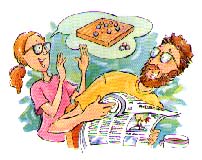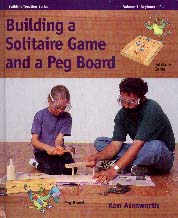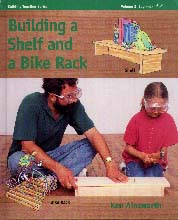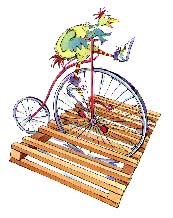|
________________
CM . . . .
Volume V Number 15 . . . . March 26, 1999
Ken Ainsworth. Photographs by Rodrigo Moreno. Illustrated by Tina Holdcroft.
Grades 3 - 6 / Ages 8 - 11.
** /4
excerpt: Dad and Lindsey got their board from the garage. Dad said, "We'll have to check the end to see if it's square." Lindsey took his try square and fitted it around the corner of the board. They could see a big gap between the board and the blade. "We'll cut it straight," said Dad.  Do-it-yourself woodworking projects for kids and their parents are
described in these first two volumes of the "Building Together Series."
Ainsworth, a professional woodworker and industrial arts teacher, believes
that time spent building something as a family will result, not only in a
useful product, but also in positive, loving relationships between parents
and their children. His kid-centered approach involves the children as
much as possible.
Do-it-yourself woodworking projects for kids and their parents are
described in these first two volumes of the "Building Together Series."
Ainsworth, a professional woodworker and industrial arts teacher, believes
that time spent building something as a family will result, not only in a
useful product, but also in positive, loving relationships between parents
and their children. His kid-centered approach involves the children as
much as possible.
Each volume provides instructions for two projects, neither of which requires power tools. The projects are introduced by a page on safety precautions- for example, "woodworkers" of all ages are encouraged to wear safety goggles for their own protection. Next is a list of required tools and materials. Most of the materials can generally be found in any home toolbox, while others can be purchased inexpensively at the local lumberyard or hardware store. A brief personal anecdote from the author's family explains the idea behind the project. Most readers will likely skip the anecdote and go right to work.
The format of the two books is the same. Four full-colour photographs per
double-page spread show Ainsworth and his daughter demonstrating the steps
involved in the project. Beneath each photo is a paragraph describing
"how-to" and offering helpful hints. Sidebars, each featuring a wacky
cartoon bird, explain woodworking terminology, the correct use of tools
and additional tips to ensure the project's success. Interspersed
throughout the text are related stories, mostly conversational in nature,
which tell how the project was first conceived or how it turned out.
Text is written, for the most part, in kids' language, but is meant for parent and child to read together. Preferably, the parent will read the book first to get a feel for the project and the degree of difficulty as well as its appropriateness to the child's age and abilities. Though Ainsworth emphasizes fun over a perfect finished product and his idea of fostering family togetherness through building is basically a good one, he could have done without the narrative style and the personal anecdotes between projects and especially in the description of the steps. For example, rather than simply giving the instruction, he tells what his daughter did and incorporates it into the instruction. This wordiness is annoying to anyone who likes to read directions a few times before beginning to work or to someone who must reread a step to check whether the job has been done correctly. In the space saved by eliminating the dialogue and the "story" parts, Ainsworth could have presented a third project. One of the series' strengths is that the author's co-woodworker is a young girl--his daughter--who acts as a role model for other females in a traditionally male-dominated endeavor. Another strength lies in the crystal-clear photographs, including a number of close-ups, all of which match the text perfectly. The remainder of the illustrations are cartoon like, colourful and bright. Basically, the premise of this series is a good one, but the text needs some revision. Be prepared to read a lot of extraneous text. Recommended with reservations. Gail Hamilton is the teacher-librarian at Bird's Hill School, East St. Paul, Manitoba.
To comment on this
title or this review, send mail to cm@umanitoba.ca.
Copyright © the Manitoba Library Association.
Reproduction for personal use is permitted only if this copyright notice
is maintained. Any other reproduction is prohibited without
permission.
Published by
TABLE OF CONTENTS FOR THIS ISSUE - MARCH 26, 1999.
SEARCH |
AUTHORS |
TITLES |
MULTIMEDIA |
PROFILES |
BACK ISSUES |
CMARCHIVE |
HOME
|



